There’s something magical about Pączki. These soft, golden Polish doughnuts are more than just a sweet indulgence—they’re a warm reminder of tradition, family, and the joy of making something special by hand.
Growing up, I remember watching my grandmother dust dough with flour, her kitchen filled with the scent of yeast and vanilla. Pączki were a once-a-year treat, tied to holidays and celebrations, but more than that, they were a way of gathering. One person rolled the dough, another filled them with jam, and everyone snuck a warm one before the glaze even had time to set.
That’s the feeling I want to bring into your kitchen today. Whether you’re carrying on a family tradition or trying these for the very first time, this recipe walks you through every step to help you create something soft, rich, and filled with love.
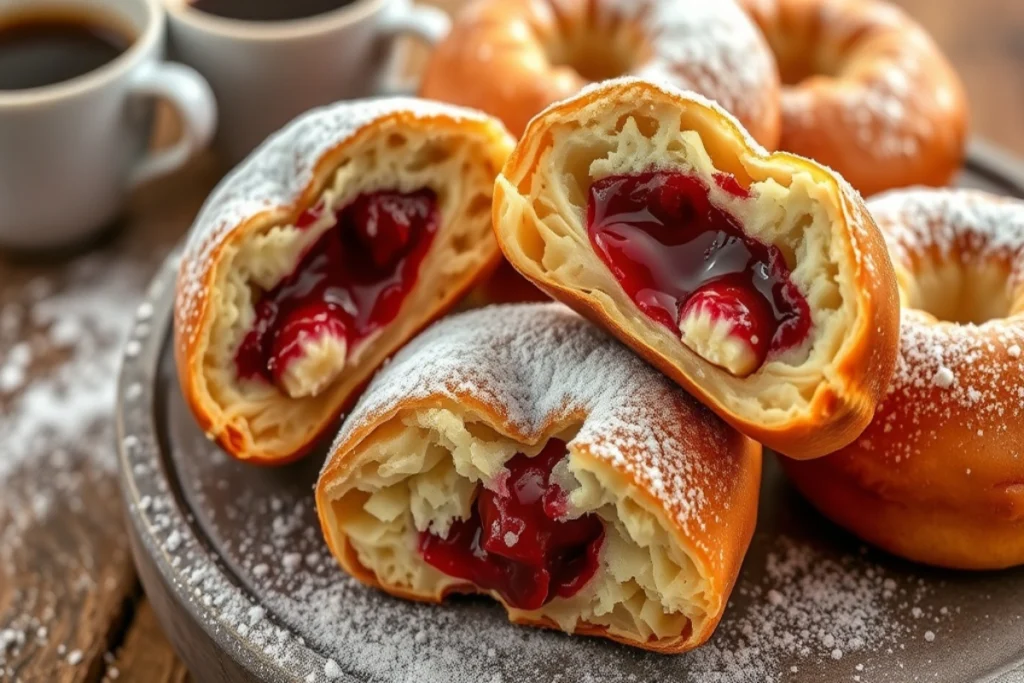
The History & Tradition of Pączki
Pączki date back to the Middle Ages, when Polish bakers first created these fried dough pastries as a way to use up ingredients like sugar, butter, and eggs before the fasting season of Lent. Over time, they evolved into a beloved national treat, often filled with rosehip jam, plum butter, or custard and enjoyed as part of pre-Lenten celebrations.
In Poland, Tłusty Czwartek (Fat Thursday) marks the final Thursday before Ash Wednesday, and it is the most popular day of the year for eating Pączki. People line up at bakeries early in the morning to get their hands on freshly made batches, sometimes eating multiple in one sitting!
In the United States, particularly in cities with large Polish communities like Chicago, Detroit, and Milwaukee, these treats are commonly enjoyed on Fat Tuesday (Mardi Gras). Polish bakeries and supermarkets sell thousands of them in the weeks leading up to the celebration.
Now, let’s dive into what makes Pączki different from regular doughnuts and how you can recreate them at home.
What Makes Pączki Different from Doughnuts?
At first glance, Pączki may look like standard doughnuts, but they have a few key differences that make them stand out:
- Richer Dough – Pączki dough contains more egg yolks, butter, and milk than traditional doughnuts, making them softer, more tender, and slightly chewy.
- Golden Brown Exterior – Unlike regular doughnuts, Pączki have a deeper brown crust with a distinct light ring around the middle, indicating a perfect fry.
- Traditional Fillings – Pączki are typically filled with rose jam, plum butter, or custard, while American-style doughnuts often have chocolate or fruit fillings.
- Dusting or Glaze – Instead of heavy frosting, Pączki are lightly dusted with powdered sugar or coated with a thin glaze, giving them a delicate sweetness.
How to Make Authentic Pączki at Home
Making these traditional Polish doughnuts from scratch requires time and patience, but the results are absolutely worth it. Below is a classic recipe that produces light, fluffy treats with a delicious fruit or custard filling.
Ingredients (Makes About 16 Pączki)
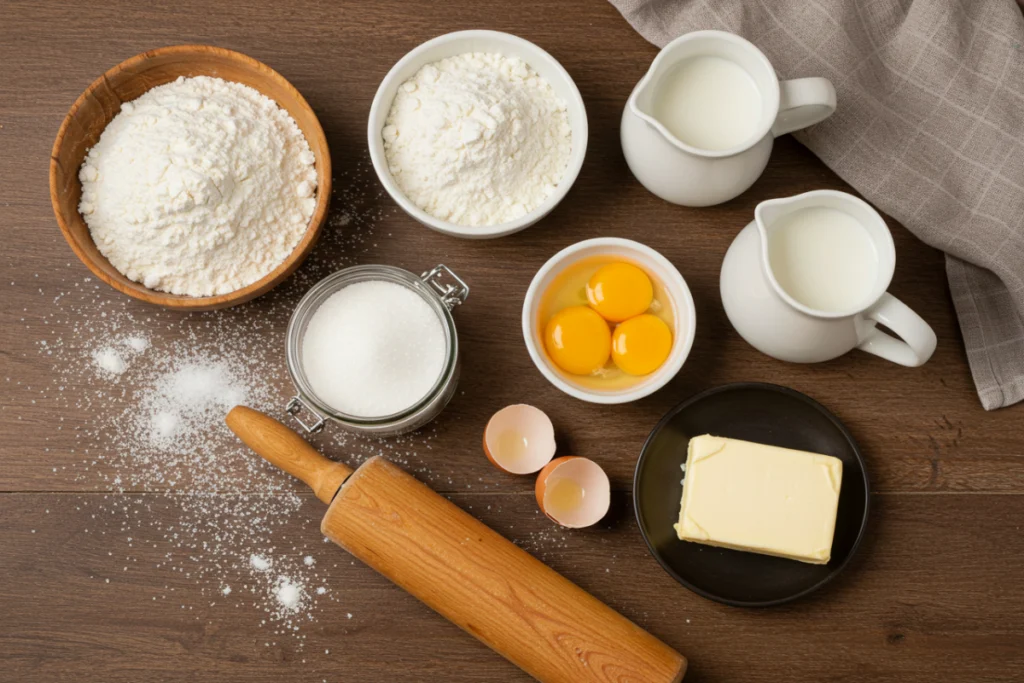
Dough:
- 1 cup whole milk (warmed to 110°F)
- 2 packets (4½ teaspoons) active dry yeast
- ½ cup granulated sugar
- 6 tablespoons unsalted butter (melted and cooled)
- 7 large egg yolks
- 1 whole egg
- 1 teaspoon fine sea salt
- 1 tablespoon vanilla extract
- 4 cups all-purpose flour (sifted)
- Vegetable oil (for frying)
Filling & Topping:
- 2 cups smooth jam (rosehip, plum, raspberry, or custard)
- Powdered sugar (for dusting)
- Pączki glaze (optional, see below)
Glaze (Optional):
- ½ cup powdered sugar
- 2 tablespoons hot water
- ½ teaspoon vanilla extract
Step-by-Step Instructions
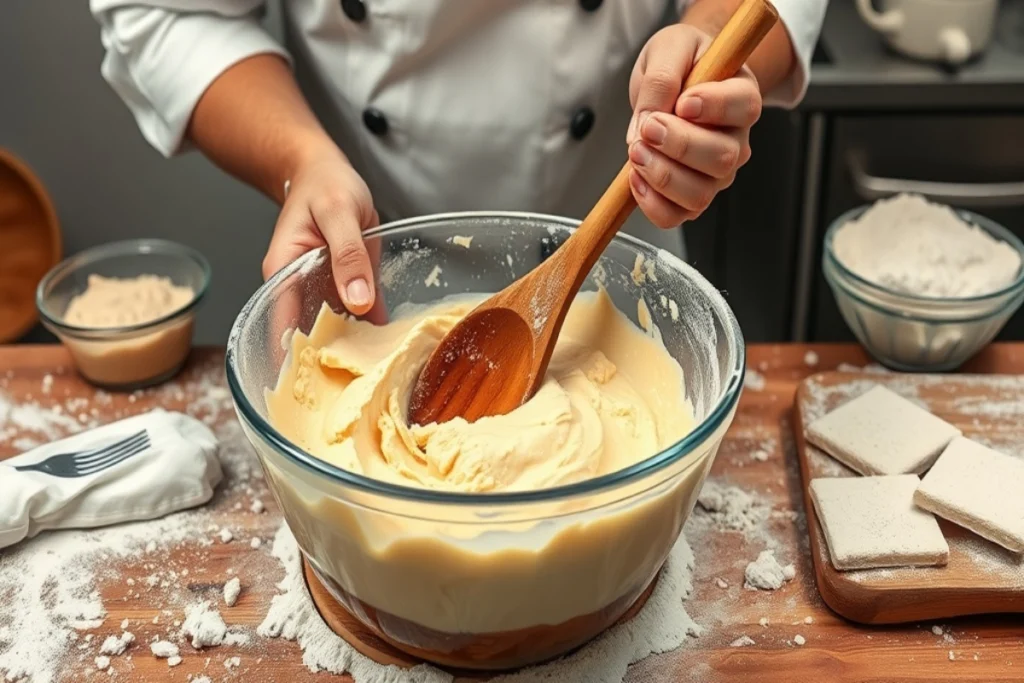

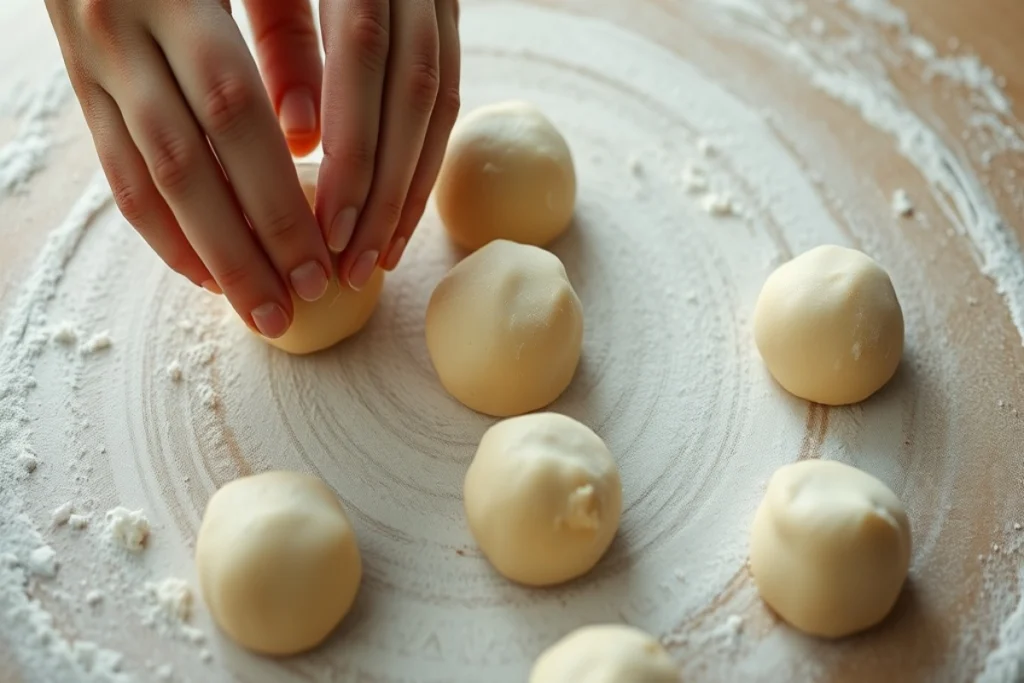
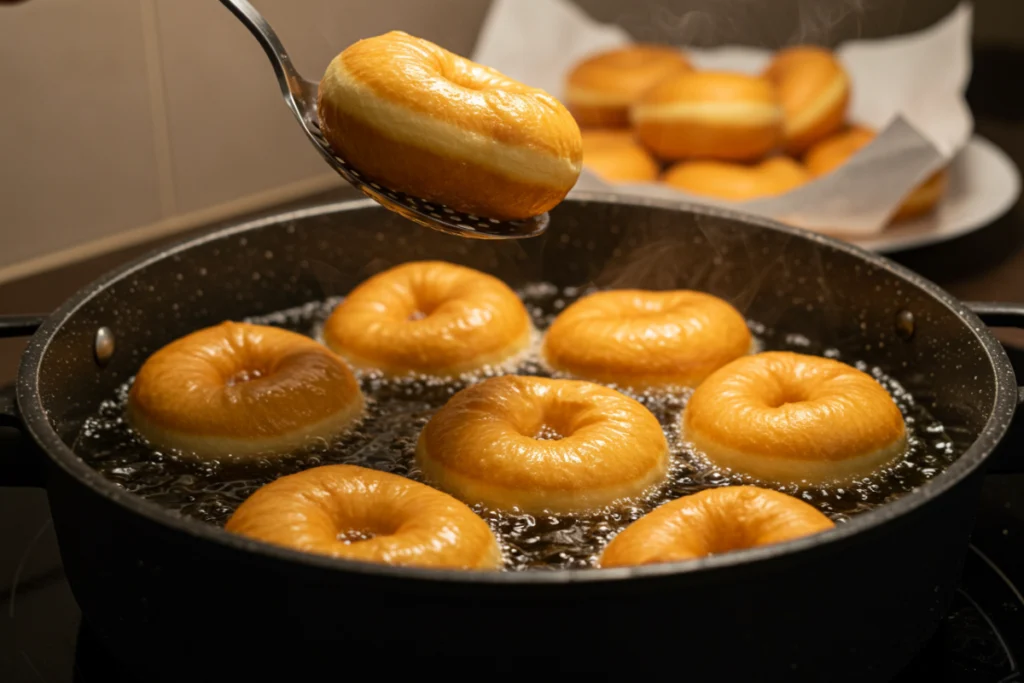
Step 1: Activate the Yeast
Warm the milk to 110°F (43°C) and pour it into a bowl. Add the yeast and 1 tablespoon of sugar, stirring gently. Let it sit for 5–10 minutes until it becomes foamy. This ensures the yeast is active and ready to help the dough rise.
Step 2: Prepare the Dough
In a large bowl, whisk the egg yolks, whole egg, remaining sugar, salt, and vanilla extract, until smooth. Add the melted butter and mix well. Gradually add the yeast mixture and sifted flour, stirring until a sticky dough forms.
Step 3: Knead & Let the Dough Rise
Knead the dough on a lightly floured surface for 10–12 minutes until it becomes smooth and elastic. Place it in a greased bowl, cover it with a kitchen towel, and let it rise in a warm spot for 1½ to 2 hours, or until it doubles in size.
Step 4: Roll & Cut the Dough
Once the dough has risen, gently deflate it and roll it out to ½-inch thickness on a floured surface. Use a 3-inch round cutter to cut out circles. Place them on a parchment-lined baking sheet, cover with a towel, and let them rise again for 30–45 minutes.
Step 5: Fry the Pączki
Heat 3 inches of vegetable oil in a deep pot to 350°F (175°C). Carefully place 3–4 Pączki in the hot oil, frying for 2–3 minutes per side until deep golden brown. Remove them with a slotted spoon and drain on a paper towel-lined plate.
Step 6: Fill & Finish
Once cool enough to handle, use a skewer or piping nozzle to create a small hole in each Pączek. Fill a piping bag with jam or custard and squeeze about 1 tablespoon into each doughnut. Dust them with powdered sugar or brush with Pączki glaze for extra sweetness.
Serving & Storage Tips
Pączki taste best fresh on the day they are made but can be stored at room temperature in an airtight container for up to two days. To keep them longer, freeze them without filling and reheat in an oven before serving.
Pro Tip: Avoid refrigerating Pączki, as the cold temperature makes them stale faster.
Make & Enjoy Authentic Pączki
Pączki are more than just doughnuts—they represent a rich Polish tradition that has been passed down for centuries. Whether enjoyed on Fat Thursday, Fat Tuesday, or any time of the year, these decadent, jam-filled pastries bring warmth and sweetness to any occasion.
Now that you have a foolproof recipe, try making a batch at home and enjoy the true taste of Poland with every bite!
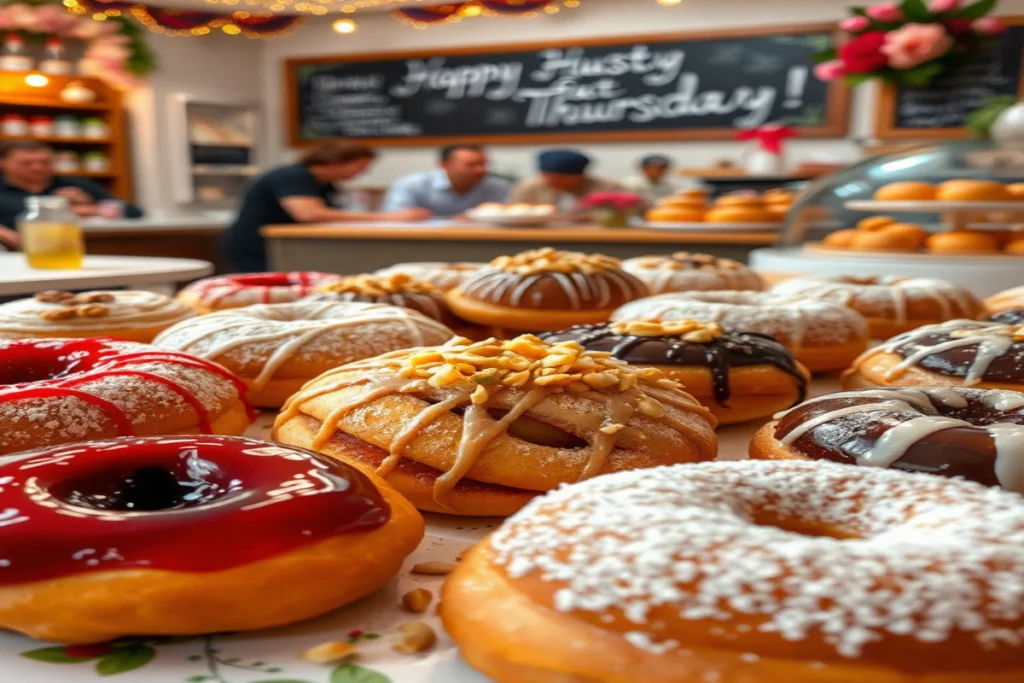
Frequently Asked Questions
Pączki have a richer, more decadent dough than regular doughnuts because they contain extra egg yolks, butter, and milk, which make them softer and more tender. Unlike traditional doughnuts, Pączki are typically filled with fruit jam, custard, or rosehip preserves and have a distinct golden-brown exterior with a light ring around the middle. They are also denser and less airy than standard American-style doughnuts.
Yes! While traditional Pączki are filled with jam or custard, you can enjoy them plain. Some people prefer to eat them without filling and simply dust them with powdered sugar or coat them with a light glaze. This variation still delivers the same rich, pillowy texture and deep-fried flavor without the added sweetness of a filling.
While frying gives Pączki their signature golden crust and airy texture, baking them is an alternative if you want a lighter version. To bake, place the shaped dough on a parchment-lined baking sheet, let them rise, then bake at 375°F (190°C) for 12–15 minutes until lightly golden. However, baked Pączki will have a softer crust and a slightly different texture compared to the traditional fried version.
Pączki taste best fresh on the day they are made, but you can store them in an airtight container at room temperature for up to two days. To keep them longer, freeze unfilled Pączki for up to two months. When ready to eat, reheat them in an oven at 300°F (150°C) for 5 minutes to restore some crispness. Avoid refrigerating them, as cold temperatures cause them to dry out faster.
Exploring Other Delicious Doughnut Varieties
While Pączki are a classic Polish favorite, other doughnuts offer unique textures and flavors. Mini doughnuts provide a bite-sized treat, perfect for snacking and parties. Learn more in Mini Donuts: The Ultimate Guide to Bite-Sized Treats.
For something different, mochi doughnuts combine a crispy exterior with a chewy, stretchy center. Their unique texture makes them a rising trend in desserts. Discover why in Why Mochi Donuts Are the New Trend in Desserts.
Whether you love traditional or modern twists, there’s a perfect doughnut for everyone!
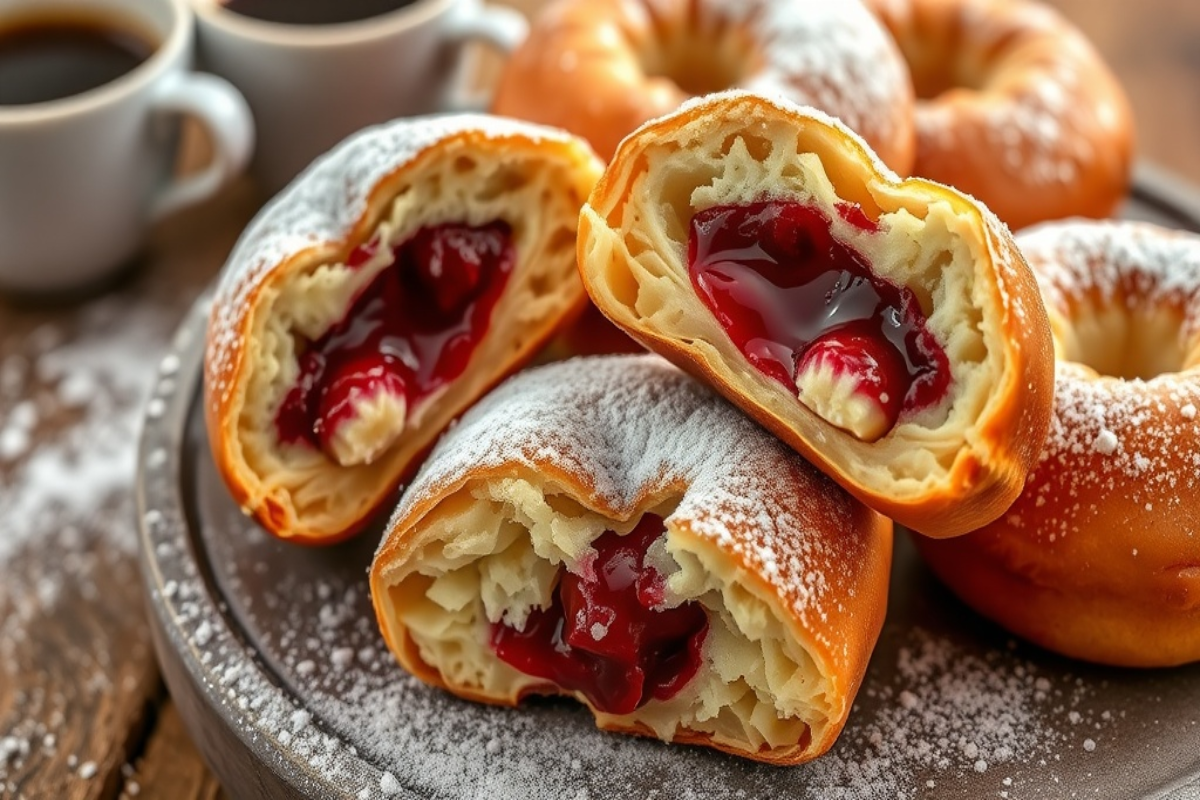
Authentic Polish Pączki (Jam-Filled Doughnuts)
Ingredients
For the Dough:
- 1 cup whole milk warmed to 110°F
- 2 packets 4½ teaspoons active dry yeast
- ½ cup granulated sugar
- 6 tablespoons unsalted butter melted and cooled
- 7 large egg yolks
- 1 whole egg
- 1 teaspoon fine sea salt
- 1 tablespoon vanilla extract
- 4 cups all-purpose flour sifted
- Vegetable oil for frying
For the Filling & Topping:
- 2 cups smooth jam rosehip, plum, raspberry, or custard
- Powdered sugar for dusting
For the Optional Glaze:
- ½ cup powdered sugar
- 2 tablespoons hot water
- ½ teaspoon vanilla extract
Instructions
Step 1: Activate the Yeast
- Warm the milk to 110°F (43°C) and pour it into a bowl.
- Add the yeast and 1 tablespoon of sugar, stirring gently.
- Let sit for 5–10 minutes until foamy.
Step 2: Prepare the Dough
- In a large bowl, whisk the egg yolks, whole egg, remaining sugar, salt, and vanilla extract until smooth.
- Add the melted butter and mix well.
- Gradually add the yeast mixture and sifted flour, stirring until a sticky dough forms.
Step 3: Knead & Let the Dough Rise
- Knead the dough on a floured surface for 10–12 minutes until smooth and elastic.
- Place in a greased bowl, cover with a towel, and let rise in a warm spot for 1½ to 2 hours, or until doubled in size.
Step 4: Roll & Cut the Dough
- Once risen, gently deflate the dough and roll it out to ½-inch thickness.
- Use a 3-inch round cutter to cut circles.
- Place on a parchment-lined baking sheet, cover, and let rise again for 30–45 minutes.
Step 5: Fry the Pączki
- Heat 3 inches of oil in a deep pot to 350°F (175°C).
- Fry 3–4 Pączki at a time, 2–3 minutes per side, until deep golden brown.
- Remove and drain on a paper towel-lined plate.
Step 6: Fill & Finish
- Once cool, use a skewer or piping nozzle to create a hole in each Pączek.
- Fill a piping bag with jam or custard and squeeze 1 tablespoon into each.
- Dust with powdered sugar or brush with glaze for extra sweetness.
Notes
NB: Craving more cozy, tasty recipes? Join me on Facebook, Medium, and Pinterest for daily inspiration, kitchen tips, and comforting meals you’ll want to make repeatedly!
